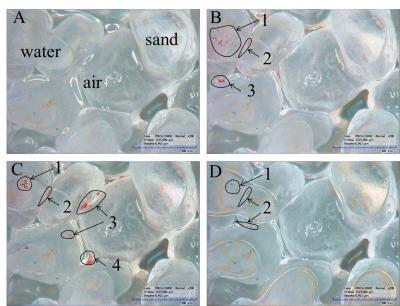If there is a spill, the chemical makeup of wastewater generated by fracking could cause the release of tiny particles in soils that might bind heavy metals and pollutants, Cornell University researchers have found.
The obvious response is 'don't do that' but the researchers were analyzing a possible risk scenario. Though it is contained, 10 percent of the water and chemical solution mixture injected at high pressure into deep rock strata surges back to the surface during well development. Scientists at Cornell studying the environmental impacts of this "flowback fluid" found that the same properties that make it so effective at extracting natural gas from shale can also displace tiny particles that are naturally bound to soil, causing associated pollutants such as heavy metals to leach out.
The particles they studied are colloids – larger than the size of a molecule but smaller than what can be seen with the naked eye – which cling to sand and soil due to their electric charge.
The effects of hydrofracking flowback fluid on colloid mobilization in unsaturated sand. Included are the injection of the colloids into the sand column at the beginning of the experiment, the deionized water flush at 0.3 ml/min, the flowback water flush at 0.3 ml/min, and the flowback water flush at 1.5 ml/min. Credit: Cornell University
In lab experiments, when glass columns are filled with sand and synthetic polystyrene colloids and then the columns are flushed with different fluids – deionized water as a control, and flowback fluid collected from a Marcellus Shale drilling site – different rates of flow led to a different amount of colloids that were mobilized.
On a bright field microscope, the polystyrene colloids were visible as red spheres between light-grey sand grains, which made their movement easy to track. The researchers also collected and analyzed the water flowing out of the column to quantify the colloid concentration leaching out.
They found that fewer than five percent of colloids were released when they flushed the columns with deionized water. That figure jumped to 32 to 36 percent when flushed with flowback fluid. Increasing the flow rate of the flowback fluid mobilized an additional 36 percent of colloids.
They believe this is because the chemical composition of the flowback fluid reduced the strength of the forces that allow colloids to remain bound to the sand, causing the colloids to actually be repelled from the sand.
"This is a first step into discovering the effects of flowback fluid on colloid transport in soils," said postdoctoral associate Cathelijne Stoof, a co-author on the paper.
The authors hope to conduct further experiments using naturally occurring colloids in more complex field soil systems, as well as different formulations of flowback fluid collected from other drilling sites.

Partially wetted sand grains (grey) with colloids (red) are shown. Credit: Cornell University
Stoof said awareness of the phenomenon and an understanding of the mechanisms behind it can help identify risks and inform mitigation strategies.
"Sustainable development of any resource requires facts about its potential impacts, so legislators can make informed decisions about whether and where it can and cannot be allowed, and to develop guidelines in case it goes wrong," Stoof said. "In the case of spills, you want to know what happens when the fluid moves through the soil."

Partially wetted sand grains (grey) with colloids (red) are shown. Credit: Cornell University





Comments